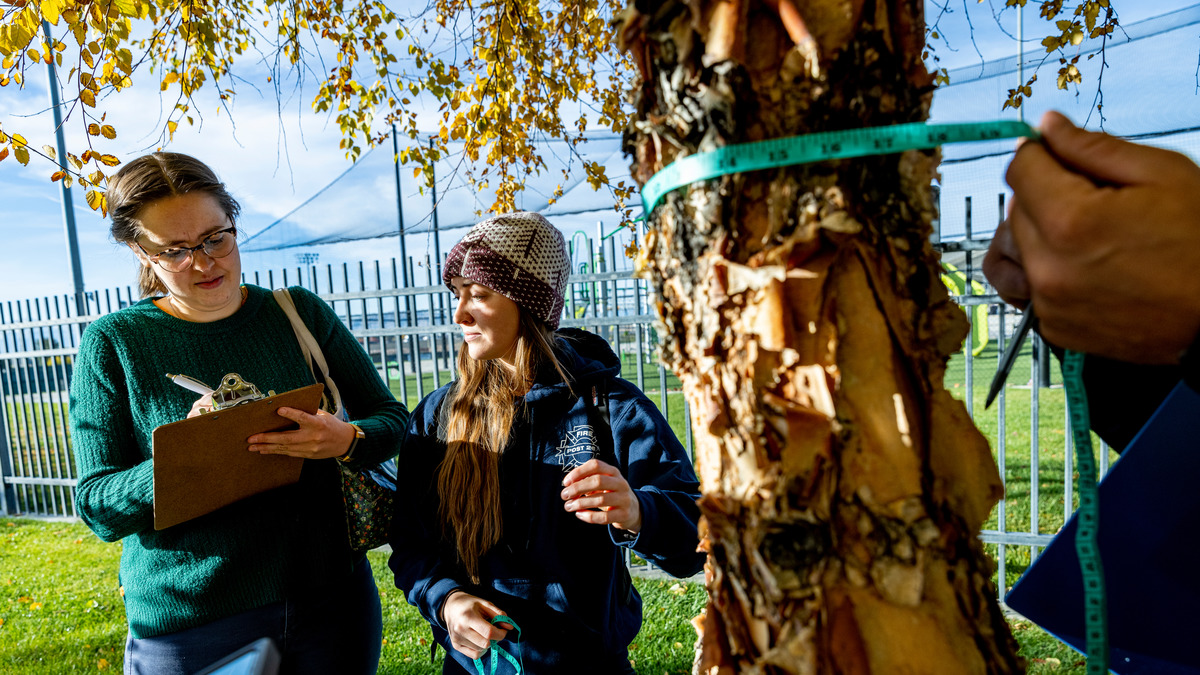On Oct. 20–21, 2021, volunteers gathered outside the Utah Valley University Orem Campus to collect vital data on 3,000 trees as part of UVU’s Sustainability Week dedicated to events promoting environmental consciousness in individuals and communities.

On Oct. 20–21, 2021, volunteers gathered outside the Utah Valley University (UVU) Orem Campus to collect vital data on 3,000 trees as part of UVU’s Sustainability Week dedicated to events promoting environmental consciousness in individuals and communities.
Sustainability Week, which ran from Oct. 18-22, featured several environmentalist events, including the Elektron Solar Project groundbreaking, Environmental Ethics Symposium, Careers in Sustainability Panel, and “Precious Pollinators” Lecture. Days three and four featured the Tree Service Learning Project, where volunteers met on UVU’s Orem campus to measure the breast height diameter (DBH) of all of UVU’s trees.
“DBH is a measurement we take on the tree to access the value of the tree,” said Kevin Hock, UVU’s lead arborist. “It gives us a ballpark figure on the tree’s age, shows us how much the tree adds to our urban canopy’s value, helps us monitor its health, and tells us how much it would cost to replace the tree in the event we took it down. Additionally, you can see how much carbon dioxide it takes in and how much oxygen it puts out.”
UVU Sustainability Coordinator Genevieve Richards remarked that it’s important to provide frequent checkups on UVU’s trees. She added that this simple measurement is crucial to seeing the tree’s carbon sequestration, a figure that shows how much carbon dioxide the tree absorbs from its environment.
“This service project is intended to underscore the fact that these trees are an important asset and resource on campus, and we need to preserve them,” Richards said. “By entering the DBH and the species of tree into our tree mapping software, we can determine how many pounds of carbon a year the tree absorbs. This process is crucial if we want to mitigate climate change.”
Senior botany major and Tree Service Learning Project volunteer Olivia Grant spent her first day measuring over 100 of UVU’s trees. Following the service project, Grant said that global environmental sustainability lies in our thoughts and actions.
“It means to be environmentally aware, to recycle, and even just take a couple days in the week to ride your bike instead of driving. Here at UVU, we can all do it. It’s easy!”
Grant added, “Climate change is a thing, and I think everyone needs to be aware of it and make daily decisions that help the environment.”
Stacy Hamm, UVU architectural project manager and Tree Advisory Committee chair, said that the Tree Service Learning Project is vital to the health of the campus’s trees and UVU’s mission to stay a “green campus.”
“This project is first and foremost for our campus. It gives us important data that helps us understand how we can be better stewards of our campus trees,” Hamm said. “Sometimes, in the course of our construction projects, we have to tear down trees. It’s just the name of the game. There’s a serious cost to that, and we don’t take it lightly. For every tree we cut down, we try to replace it with two trees. We’ll even try to replenish the torn down tree with a higher caliber tree.”
Hamm remarked that sustainability lies in every facet of her work and in all UVU’s campus construction and renovations.
“There are so many aspects that contribute to sustainability,” she said. “In construction, we pursue sustainability in our construction sights, water efficiency, and materials and try to be environmentally aware in all we do. Sustainability is being mindful of your impact wherever you go and whatever you do.”
In 2018, UVU received the Tree Campus Higher Education (TCHE) designation, a recognition administered by the Arbor Day Foundation that encourages higher education institutions to promote healthy urban forestry. To meet the requirements for this recognition, UVU complied with the following five requirements:
“We’re so proud to be part of the Tree Campus Higher Education,” Hamm said. “It shows our commitment to the environment and our community. It surprised me to see how many other cities and schools in Utah are a part of TCHE. It helps give us a sense of purpose and camaraderie.”
To learn more about what UVU is doing to be the “green” campus, visit uvu.edu/sustainability.